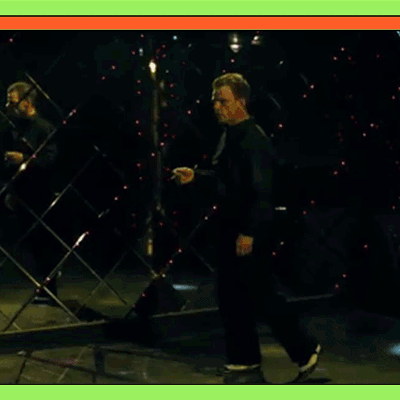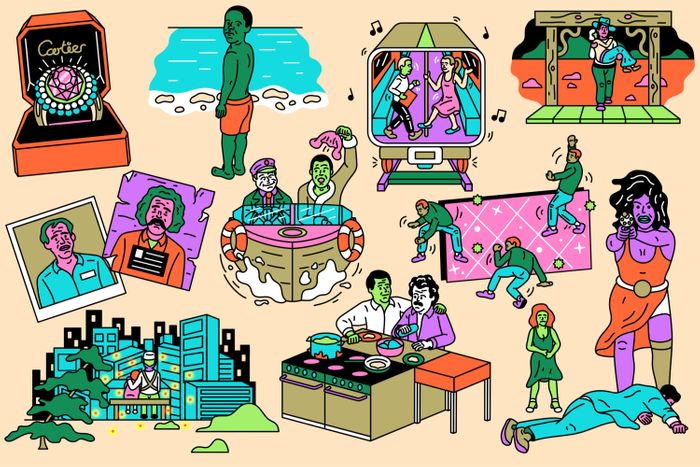
Federico Fellini may not be the obvious touch-point for an ABBA jukebox musical, but the finale of Mamma Mia! Here We Go Again inarguably owes something to 8½. Hear me out: Fellini’s 1963 masterpiece concludes with all of its layers of reality, memory, and fantasy collapsing into a circus, with everyone from its main character’s past and present — including his childhood self — pouring into a circus ring and joining hands for a messy, sunny promenade. The Mamma Mia! sequel closes with the last of its many musical numbers, one taking place on a stage somewhere outside the bounds of space and time where its ensemble, including characters who’ve died and some younger selves, can join together for a buoyantly costumed performance. These finales are absolutely of a kind, splitting open their respective worlds for an impossible, ecstatic musical number. Admittedly, though, only one of them involves Cher kicking off a cover of “Super Trouper.”
Musical sequences are one of those things that cinema feels like it was invented to showcase — alongside explosions, hot people, and trains coming terrifyingly at the screen. They’re the perfect way to end a movie, except when they’re hackneyed and cynical, which they frequently are. Still, to watch the finest of musical finales is to become convinced, however briefly, that every movie should end with a song and/or dance. It’s actually not nearly as narrow a choice as it might sound. For all the distance there is between Mamma Mia! 2 and 8½, there’s infinitely more space for variations between climactic music moments that unfurl within the scope of a fictional universe and ones that come from outside it. Some movies build their use of music toward a powerful finale, and others include it only as a coda. Sometimes that’s even better — as a spectacle, musical numbers are capable of a purity that makes them even more piquant outside the genre for which they’re best known.
Take The Last Days of Disco, which is devoted to the petty dramas and minor humiliations weathered by a group of 20-somethings in the early ’80s. It ends with Matt Keeslar doing a little shuffle for a laughing Chloë Sevigny on the subway, as though the two can hear “Love Train,” by the O’Jays, playing on the soundtrack, while in true New York fashion, no one else pays them any mind. But then there’s a cut and magically everyone in the car starts dancing, and out on the platform too, and it’s just so joyous. Or consider the giddiness of “Always Look on the Bright Side of Life” at the end of Life of Brian. The main character, played by Graham Chapman, is among the crucified after multiple attempts at rescue have come to nothing. The song’s couched in an ebullient irony, everyone joining in on an ode to keeping a stiff upper lip as they await a painful death — but it’s also simply exuberant, the dark context making the irresistible nature of the song even better, the figures onscreen attempting whatever minimal choreography they can manage while strapped to the crosses.
The moment in which a movie’s established reality splits open and gives way to something grander or more stylized can be electric. You don’t always need that break, though. Mads Mikkelsen’s cathartic closing dance number in Another Round is perfect because it exists in-universe, with his character, a depressive teacher, calling on the jazz-ballet lessons of his younger days for a sequence of celebratory abandon while his friends and students look on in delight. Robert Altman’s Nashville is a diegetic musical that arranges for most of its characters to intersect at a gala concert that’s interrupted by a shooting, and what follows — Henry Gibson beseeching the crowd to sing, Barbara Harris being handed the mic — is a sharp-edged satire of the act of rallying together in song, summoning the flip side of the feeling at the end of Life of Brian. The dance between Julia Roberts and Rupert Everett at the end of My Best Friend’s Wedding manages to offer some rom-com standard swooniness while also not being at all rom-com standard, bubbling over with a bittersweet satisfaction while also subverting the expectations of the genre.
Some of the greatest musical endings find themselves somewhere in between the real and unreal worlds. Bong Joon Ho’s Mother opens with an absurdist dance number, with Kim Hye-ja giving a deadpan performance alone in a field as the credits roll. The movie answers this opening scene with an ending one that takes place within the world of the story, and that’s just brutal in its implication of maternal ties as this monstrous burden, its heroine trying to shimmy away from what she’s learned about herself and the child she’s devoted her life to. Meanwhile, the sublime conclusion to Claire Denis’s Beau Travail is a scene that could be a fantasy or a flashback, or the death dream of a man in the process of killing himself. It’s part of the movie and yet it’s untethered, with the French Foreign Legion soldier played by Denis Lavant alone in a mirrored nightclub, flinging himself around to “The Rhythm of the Night.” His character, so locked down for so much of the run time, and so seemingly disconnected from his own desires, suddenly appears liberated, and yet the sequence carries with it tremendous sadness.
The way that it floats apart from the rest of the film and yet remains so central to it underscores the power of a musical number to convey emotions that can’t be articulated in straight scenes. There’s more there, in Beau Travail’s ambiguous yet intensely eloquent finale, than can be put into words. It’s an effect worth remembering, especially in the face of all the tacked-on finales that have been left so far unmentioned here — the kind that have the Minions dancing to “Y.M.C.A.,” the characters in the Shrek movies getting down to “I’m a Believer” (twice!) and “Livin’ la Vida Loca,” and add up to a playlist worthy of a wedding reception in hell. They’re worth enduring for the unmatchable satisfaction that comes with a musical ending that’s earned. At the end of Ella Enchanted, before the film goes out with all its characters singing a deeply unnecessary rendition of “Don’t Go Breaking My Heart,” Eric Idle informs the camera that “you just can’t go wrong if you follow your heart and end with a song.” Obviously, you can, but Idle put it better back in 1979 when, strapped to a cross, he sang, “Forget about your sin, give the audience a grin, enjoy it, it’s your last chance anyhow.”
More From This Series
- No, They Weren’t Dead the Whole Time
- Harrison Ford Didn’t Do It
- What Makes Viewers ‘Tune In Next Week"?



